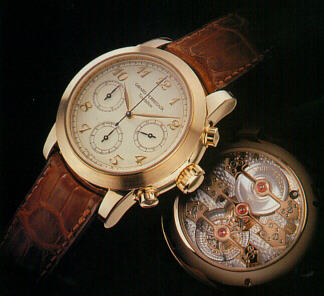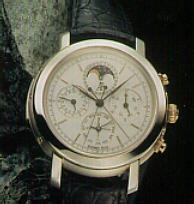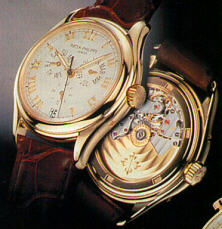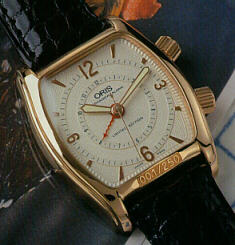
 |
 | This Master Geographique from Jaeger-LeCoultre features an automatic movement with dual time zone function. Entirely decorated, assembled and finished by hand, the watch indicates the hours, minutes and seconds of local time and a second time zone. It also shows the local date, name and day or night designation as well as the power reserve. |
| Each year since 1991, Girard-Perregaux has created a watch designed around its tourbillon mechanism made of three gold bridges. The bridges are clearly visible through the 1996 model's transparent caseback. The tourbillon powers a traditional chronograph that contains a second hand. Wearers can measure time with 30-minute and 12-hour subdials. |  |
| Fine mechanical timepieces continue to capture the imagination of U.S. consumers. The number of gold, silver and platinum automatic (self-winding) mechanical watches imported into the U.S. last year jumped more than 16% to 28,000. This increase came even though the average retail price rose to $3,593 and overall watch imports fell 9%.
These numbers indicate a strong market already, and the news may be getting even better. The audience for such timepieces seems to be widening, say many retailers. The collectors who helped to boost U.S. interest in fine mechanical watches in the late 1980s have continued spending into the 1990s. Now they're joined by consumers interested in these high-end watches for their technical wizardry or as status symbols. Advertising in general-interest and male-targeted media have heightened the prestige of automatics, particularly multifunction models. Also fueling interest is the evolution of watches as fashionable accessories, particularly automatic watches. "There are fewer accessories for men," says Peter Bigler, head of U.S. distribution for Ulysse Nardin Swiss luxury watches. "The watch, some leather goods and the pen are the items that serve this purpose." When he arrived in the U.S. about 12 years ago, Bigler says, he was amazed that so many high-income executives wore "cheap plastic digital watches." Bigler's company, along with a number of new higher-end brands and the support of jewelers with strong watch departments, have been working to change that. "I think we are now at a stage in the U.S. where consumers are interested in the intrinsic value of what they buy," he says. "Buyers are aware that they can purchase something that is less expensive and will not last long or that they can buy quality that retains value." Retailers say today's sophisticated consumers clearly see the value in automatic or handwound, handcrafted watches, many of them with multifunction capabilities. "There is a new type of buyer for this kind of watch," says Paul White, director of the watch division at Reis-Nichols, a retailer in Indianapolis. "These are typically young men, maybe 35 to 45 years old, who read magazines, are earning more discretionary income now and who have probably had some experience with a fine watch in the past." Many may already own a Rolex, the best-selling mechanical in the U.S. - passed down through the family. "That's one way watch owners are introduced to what we call a timeless timepiece, one that can be passed from generation to generation," he says. Others are simply conversant in fine watch brands, may own some and want to have another one. This customer base - including those who received automatics as gifts, new aficionados and those in search of battery-free operation - is growing, say retailers. In response, more top retailers are adding fine watch lines. |
| With only five made each year Audemars Piguet's Automatic Grande Complication is a rare timepiece that appears contemporary but is backed by a rich history of multifunctional watchmaking. Six hundred parts are hand-assembled in a watch just 8.55mm thick. Features include an 18k rotor, perpetual calendar, minute repeater that can be set with a tone to indicate hours, quarter hours and/or minutes; a split-second chronograph precise to one-fifth of a second; separate 30-minute counter, moon-phase indicator; and day, date and month indicator The piece takes four months at the factory to set and adjust. |  |
 | The automatic mechanism powering the annual calendar on this Patek Philippe is patented and the first of its kind. It indicates the 30-day and 31-day months on a yearly cycle starting March 1. This model breaks with horological tradition by replacing the Roman numeral IIII with IV, a feature it shares with the 15th century astronomical clock at Prague's city hall. |
| The classic face of this new Blancpain belies the dual complications of an automatic chronograph and a perpetual calendar. The dial features a month and year indicator at 12 o'clock, an hour and day counter at 9 o'clock, a minute and date indicator at 3 o'clock and a moon phase window at 6 o'clock. The company has made 29 of these watches commemorating 1996 as a leap year. |  |
 | The limited-edition Oris Mechanical Alarm 1996 chimes at the time set by the distinct red alarm set-hand, easily seen under a spherical cut sapphire crystal. The tonneau-shaped case is made of 18k rose gold secured in the back by four gold screws. Each watch is numbered at the lower end of the case. |
By Michael Thompson, Reprinted From Jewelers' Circular-Keystone October 1996
![]()